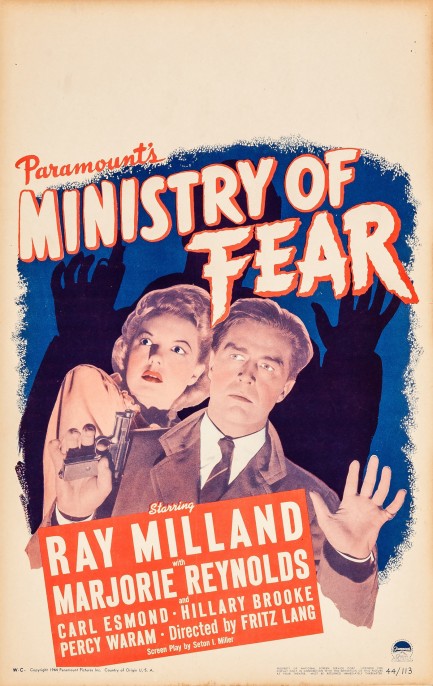 When there's a killer on the loose you'd better sleep with one eye open. 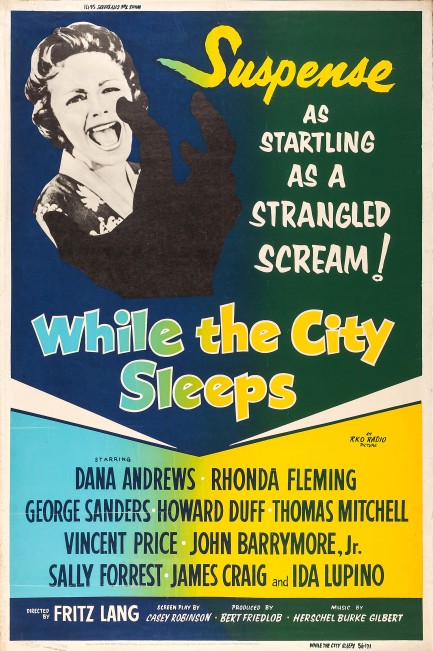
This poster for While the City Sleeps doesn't impress with masterly art the way so many vintage promos do, but its simplicity is, in an oblique sort of way, we think, meant to echo tabloid covers from the era. RKO made a special poster in collaboration with Confidential magazine, which you'll see below. The movie's plot is pure tabloid fodder. A serial killer has slain women in New York City, leaving the cryptic message “Ask mother,” written on the walls of one murder scene. Vincent Price, owner of Kyne News Service, part of a media empire comprising ten newspapers, a wire service, and other interests, offers the position of executive director to three employees in order to draw them into cutthroat competition with each other. Soon it becomes clear that finding the identity of the “lipstick killer” is the winning move. Intrigue and subterfuge take over the office. Everyone gets involved, from senior editors to stringers to gossip columnist Ida Lupino, but the killer is too clever to be caught.
At least until intrepid Pulitzer Prize winning television reporter Dana Andrews airs a scornful and taunting broadcast, deliberately setting up his own fiancée as bait. He doesn't even ask her permission. Well, he does, but only after arranging to publish their engagement announcement in the New York Sentinel right next to a story about the killer. Reckless? Yes. Presumptuous? For sure. There are intertwined plotlines here, but Andrews using his true love as a lure was the most interesting aspect for us. He isn't the only heel on display. The movie is ostensibly about a serial killer, but is really a framework for exposing backbiting and cynical ambition in the big city. Director Fritz Lang, in what was his penultimate U.S. film, explores the cruel banality of what, these days, some call “hustle culture,” and brings the production to a conclusion that's, in the words of Thomas Mitchell's character, “Neat, but nasty.” Our words are: a mandatory watch. While the City Sleeps had a special world premiere today in 1956. 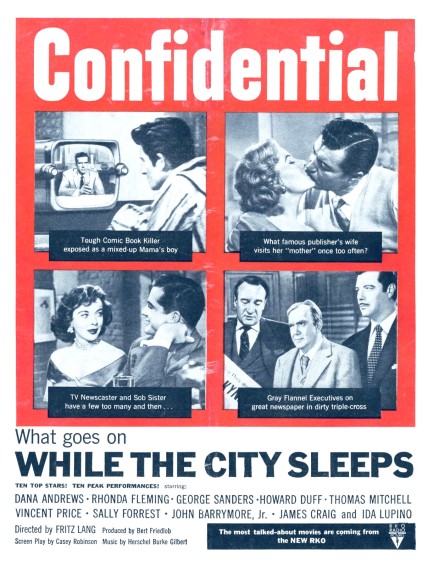 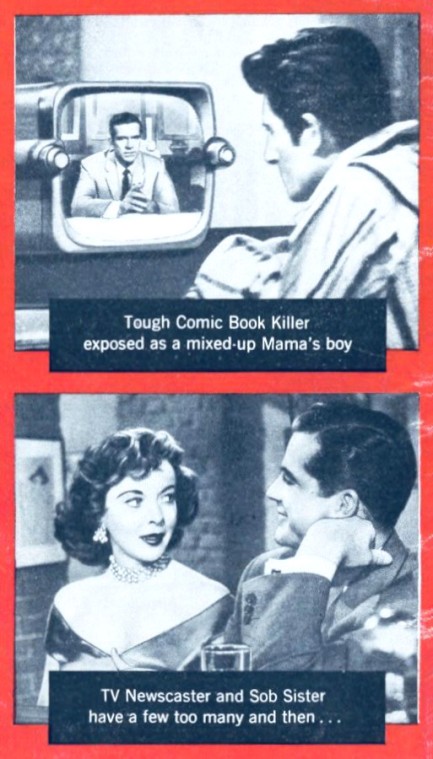 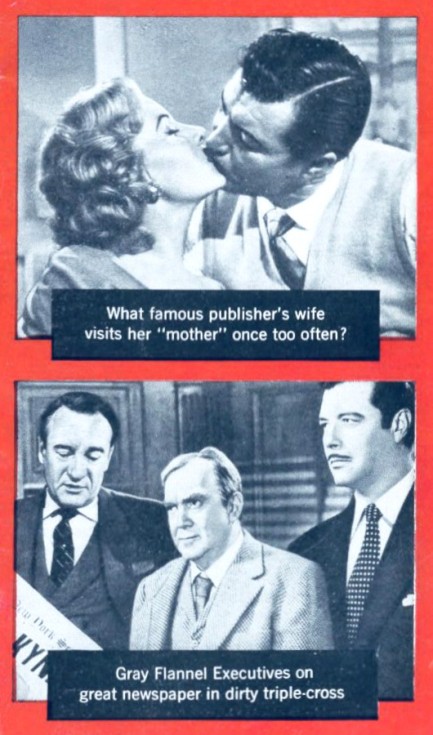 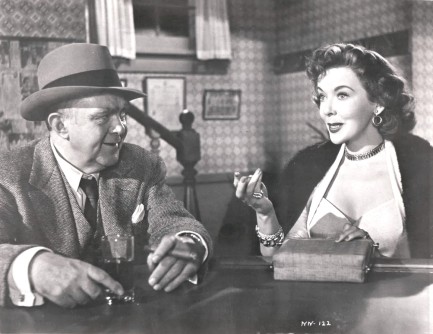 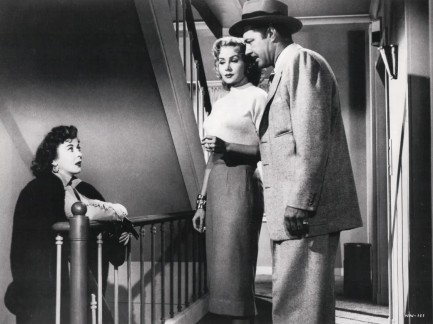 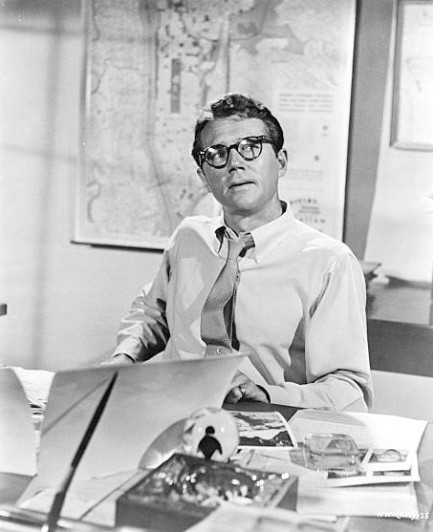 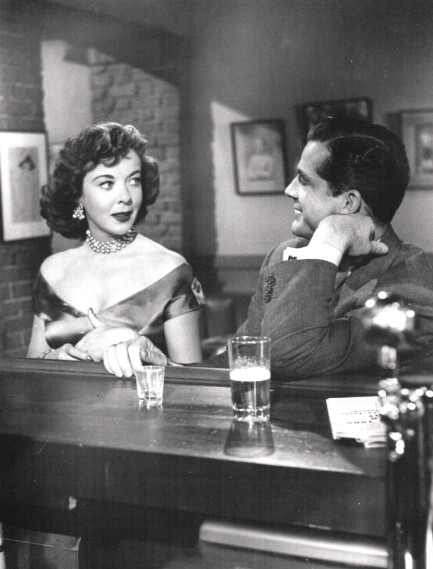 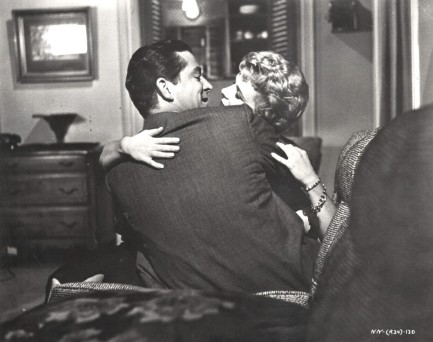 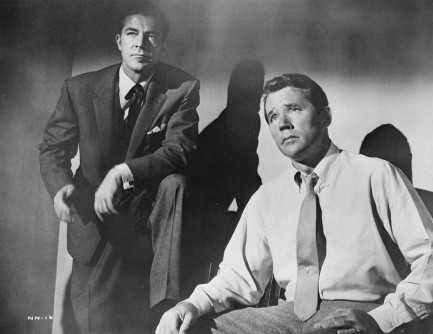 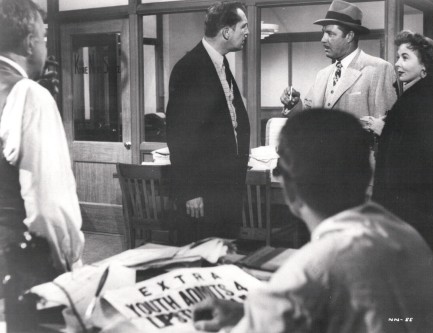 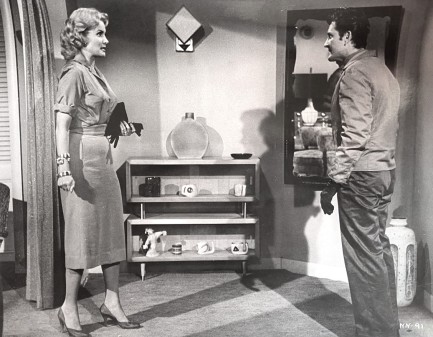 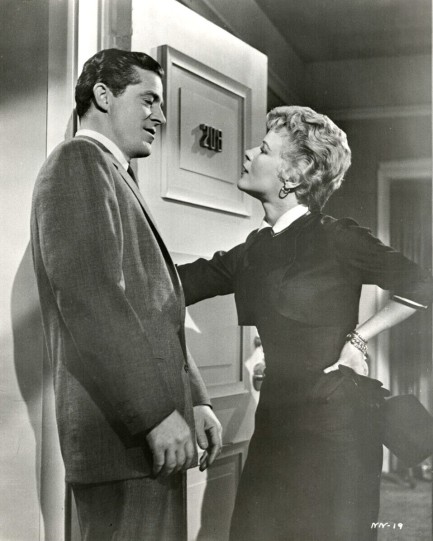 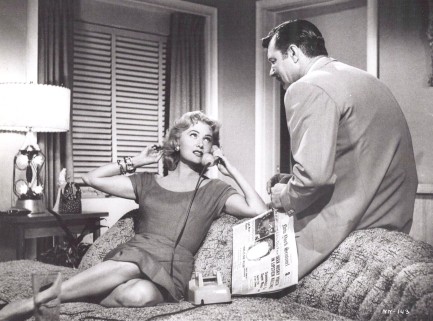 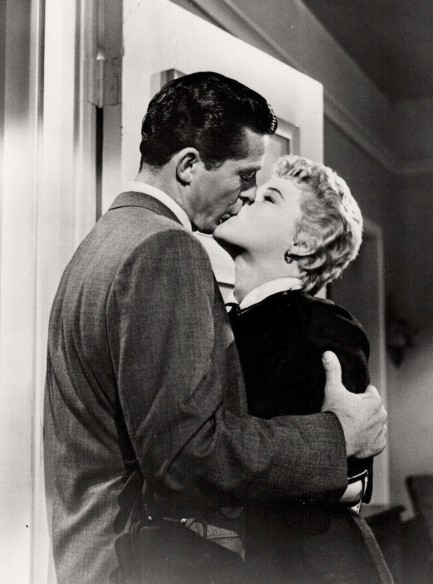 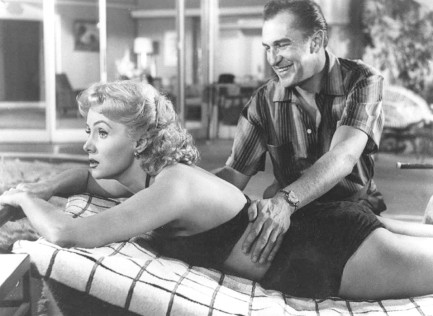 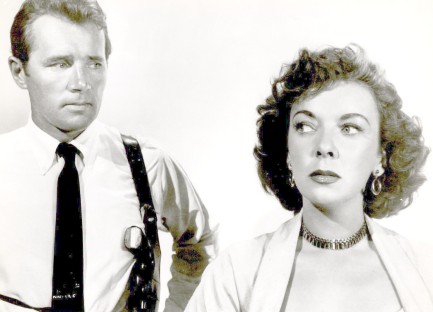 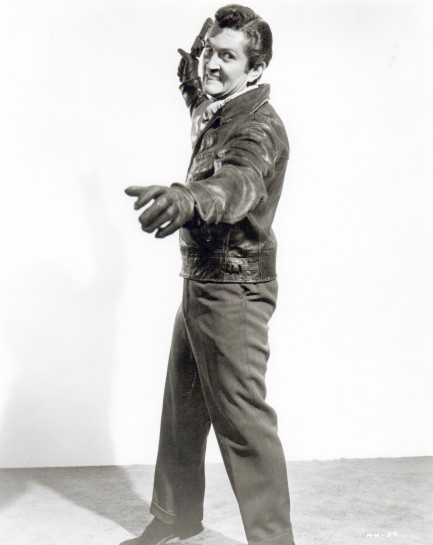 Edit: Vintage movies are excellent windows into bygone customs and practices. There's a great moment in this one. Rhonda Fleming and James Craig are chatting in her apartment late one night when the doorbell unexpectedly buzzes. They look at each other confused for a second, then Fleming says, “It's probably the drugstore. That was the last bottle of Scotch.” Edit: Vintage movies are excellent windows into bygone customs and practices. There's a great moment in this one. Rhonda Fleming and James Craig are chatting in her apartment late one night when the doorbell unexpectedly buzzes. They look at each other confused for a second, then Fleming says, “It's probably the drugstore. That was the last bottle of Scotch.”
You know, there were a lot of things wrong with the mid-century era. But there were a few things right too. Getting the all-night drugstore to deliver booze has to be one of the most right things we've ever heard of, so we give thanks to While the City Drinks—er Sleeps—for clueing us in, and suggest you call your congressional rep immediately and ask for a law allowing pharmacies to deliver alcohol. If not for yourself, do it for the children.
 Don't look. Don't move. Don't even breathe. 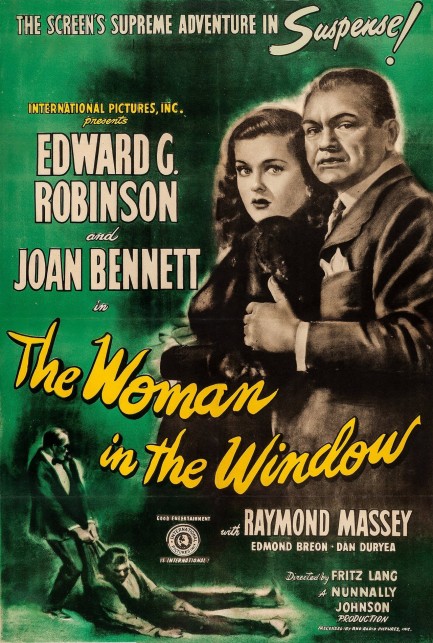
Here's a U.S. promo for Fritz Lang's film noir The Woman in the Window, which premiered today in 1944. The poster is unattributed, but it's fantastic work. There's normally a white border, but the version you always see online omits that. It's also highly saturated. We don't know if the color was the work of an industrious Photoshop user, but we do like it. However, a version that shows its real age—slightly less vibrant but still very nice—appears below. There are other differences too, such as the color of the figures and some of the lettering.
The Woman in the Window was headlined by star supreme Edward G. Robinson, who we love more with each movie we see. In this one he plays an everyman who gets into a nightmare situation over his head. That would be five feet, five inches for Robinson because he was such a diminutive guy, but the tallest man in the world would still be in deep trouble. You have to watch the movie to find out why, but you can read a little more about it and see a Swedish poster here, and a French poster here.
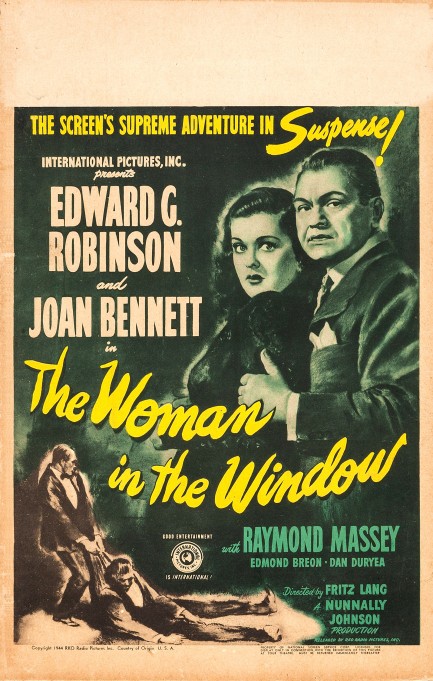
 Proceed with caution—Nazi crossing. 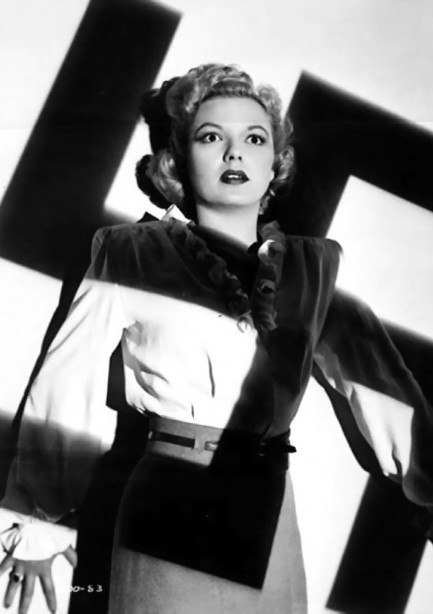
Marjorie Reynolds gives her best transfixed look in this promo image made for her 1944 film noir Ministry of Fear. The swastika leaves no doubt who the villains are. They take over a New York City brownstone and use it as a base of operations for various dastardly doings. The film is uneven despite being helmed by the legendary Fritz Lang. Reynolds, who also acted under her real name Marjorie Goodspeed, as well as Marjorie Moore, appeared in dozens of movies but wasn't quite what you'd call a star. Her signature moment probably came when she sang the song, “White Christmas,” in the 1942 film Holiday Inn. She performed it twice—once solo, and once as a duet with Bing Crosby. She didn't appear in many crime movies or thrillers, so we probably won't see her here again, but this is quite a shot to go out on. You can read what we wrote about Ministry of Fear here.
 In the Ministry of Fear they bake better than they spy. 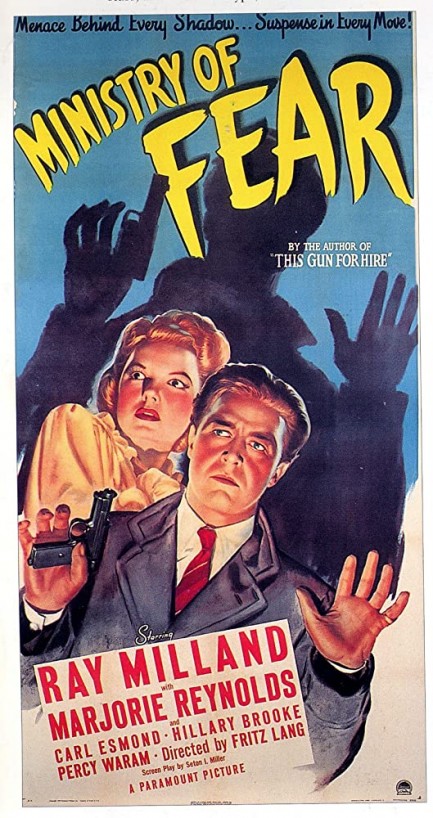
Fritz Lang was one of the most important directors of his era, both in his native Germany and in the U.S., and was a pioneer of the film noir form. Movies like Scarlet Street and especially The Big Heat are essential noir viewing. Ministry of Fear dates from a bit earlier and finds Lang saddled with what we consider to be a substandard script that through sheer artistry he makes into a watchable film. Ray Milland, Marjorie Reynolds, and Dan Duryea headline in a spy tale that revolves around Lang's favorite villains—the Nazis. Jewish and German, he left his homeland for Paris and beyond during the ascent of the Nazis during the 1930s, so the subject was personal for him, and was one he'd dealt with in previous films such as Cloak and Dagger and Hangmen Also Die.
In Ministry of Fear Milland plays a man who spends two years in a British asylum and is released at a time when World War II is raging and London is being bombed. He goes to a charity carnival and is enticed into guessing a cake's weight for a chance to win it, and because he's been given the correct answer by a fortuneteller, is victorious. But it's soon clear that the correct weight wasn't supposed to be given to him, and he isn't supposed to have won the cake. But he really wants it and resists attempts by the carny folks to take it back. He loses it during a train ride when a passenger beats the snot out of him for it, and at that point finally realizes the obvious—sweet though this confection may have been, it wasn't sought by various and sundry for its flavor, but because inside was something important. He wants answers, and he'll have to risk his neck to get them.
Generally with movies it's best to simply accept the premise, but there are limits. We were never clear on why it was necessary to put this important item in a cake. We understand subterfuge is involved in the spy game, but why not just hand the item over in an alley, or a pub bathroom, or a parked car? And if food must be involved, why a cake? Why not a haggis, or something else very few people want to just gobble up on the spot? A dried cod maybe. A blood sausage would have done. Plus they're easy to transport. You can just stick them in your pockets. And in a tight spot a whack across the nose with a blood sausage is far more effective than shoving cake in someone's mug. The cake gimmick was probably—strike that—certainly better explained in Graham Greene's source novel. We haven't read it but we're confident about that. It could have been Lang who screwed the pooch, but it was more likely Seton I. Miller. He was screenwriter as well as executive producer.
In any case Milland bumbles his way through a train trip, across a moor, in and out of a crazy séance, and into a maze of misdirection to the eventual revelation of what's inside the cake, but the whole time we kept thinking the movie should be called Ministry of Cut-Rate Spies. We don't mean to say it's a total loss. It isn't like the Eddie Izzard comedy routine, “Cake or Death.” You won't choose death over cake. But it's a pretty uninspiring flick. The old dramas that have survived have done so for a simple reason. Most of them are good. Ministry of Fear isn't bad. It's just meh. It's like a cake that fell—it's flat and dense, but teases you with how yummy it could have been. It premiered in England today in 1944.
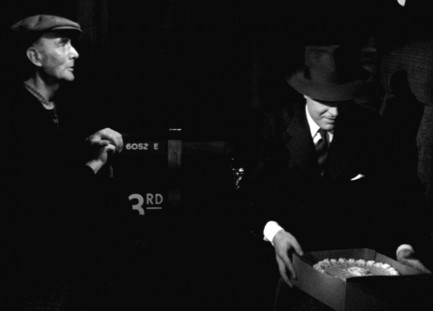 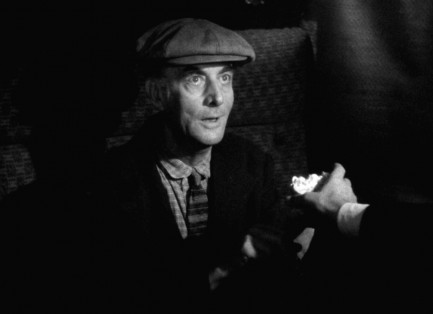 Here, have your cake. And eat it too. Heh. Here, have your cake. And eat it too. Heh.
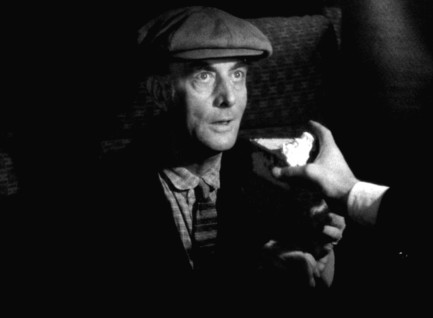 I prefer blood sausage for train trips, but I guess it's better for you I'm not shoving one of those in your face, eh? I prefer blood sausage for train trips, but I guess it's better for you I'm not shoving one of those in your face, eh?
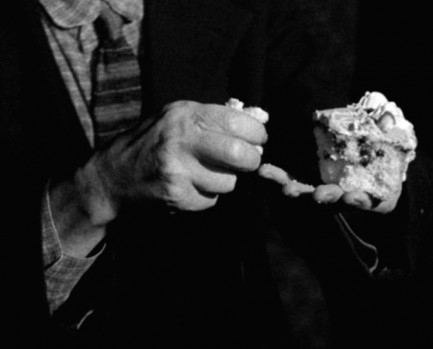 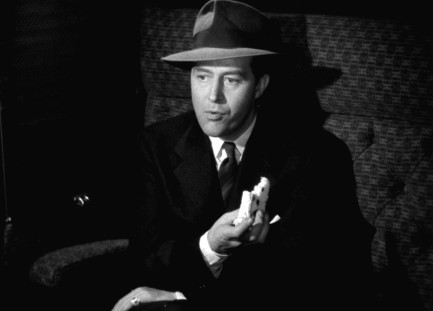 Wow, you sort of... crush the shit out of your cake before eating it. Wow, you sort of... crush the shit out of your cake before eating it.
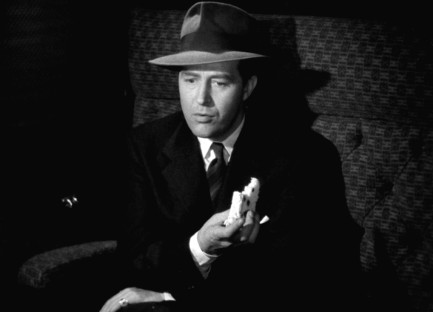 Have I been eating cake wrong the whole time I've been in England? Have I been eating cake wrong the whole time I've been in England?
 Baxter's bad night is about to get a lot worse. 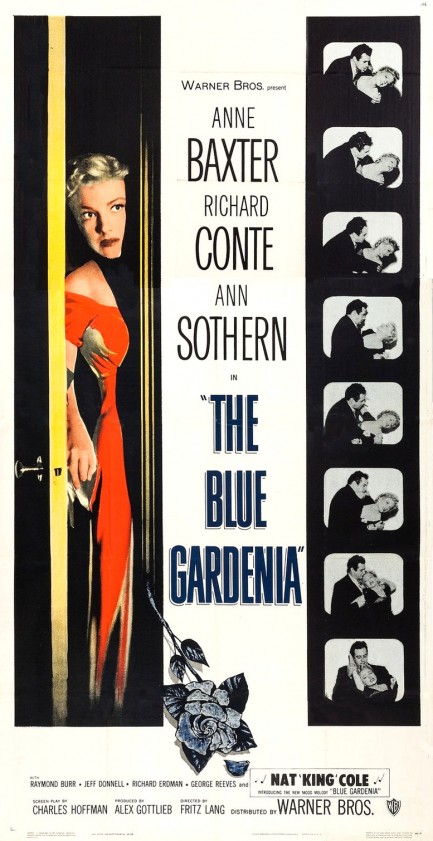
We thought the French poster we shared for Anne Baxter's The Blue Gardenia was the best promo made for the movie, and we stand by that, but this U.S. promo in three-sheet style is pretty nice too. No artist is credited with this, as it's a photo-illustration. We think it has a film noir feel to it, but even though the movie was directed by German noir legend Fritz Lang, it isn't a noir—it's a mystery/drama, one that deals with gender issues, and for vintage film buffs it's certainly worth watching.
You've noticed that the name of the film echoes the Black Dahlia murder, still somewhat on the public's mind at the time, but there are no similarities between the crime and the film. That's just sneaky marketing. Well, whatever people thought they were getting when they ponied up their cash to watch this, what they got was an okay-not-great showcase for Baxter's top notch acting skills. The Blue Gardenia premiered in the U.S. today in 1953. You can read our detailed discussion of it here. 
 Gestapo goes to extraordinary lengths to cancel a Czech. 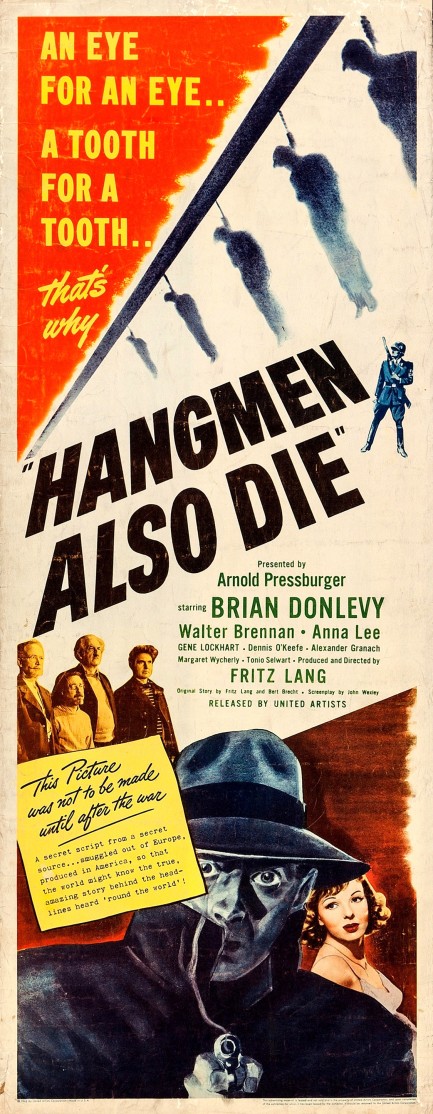
This striking poster for Hangmen Also Die might make you think you're dealing with a death row film noir, but it's actually a war drama about the Nazi occupation of Czechoslovakia. When a Czech assassin played by Brian Donlevy shoots the country's cruel German administrator Reinhard Heydrich and escapes into Prague's urban maze, the Nazis start executing people to force the population to turn over the shooter. As people die Donlevy struggles over whether to turn himself in. This was made in 1943 and qualifies as war propaganda, complete with flourishes such as discordant brass when Hitler's portrait appears onscreen, and a cheeseball closing song with a chorus of, “No surrender!” And to just bang the war drum even more, the movie premiered in, of all places, Prague, Oklahoma today in 1943, and the showing featured hanged effigies of Hitler, Hirohito, and Mussolini, while regional politicians made a point of attending. That must have been some night.
But while Hangmen Also Die may qualify as propaganda, it certainly isn't untrue in any major sense. The film's two architects, German director Fritz Lang and German writer Bertolt Brecht, both left their homeland to avoid the Nazis, and we can only imagine that their personal experiences made this project deeply important to them. But even people working from personal experience need help, and they get a major boost from co-star Walter Brennan. You'll sometimes read about him being a great character actor and this movie proves it. Watch him in this, then as the drunkard Eddie in To Have and Have Not, and you'll find him physically unrecognizable. Only his distinctive voice identifies him as the same person. Meanwhile it's Donlevy who's asked to personify the classic moral dilemma of sacrifice for the greater good, and he's mostly successful at portraying it as a heavy burden. While we wouldn't call Hangmen Also Die a great movie, there's no doubt it occupies its niche comfortably.  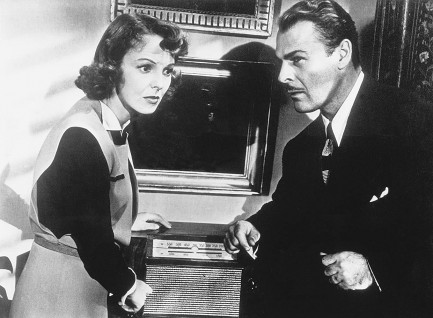 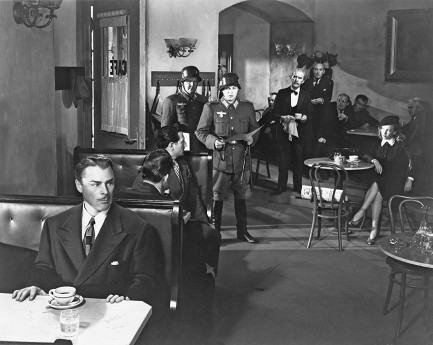 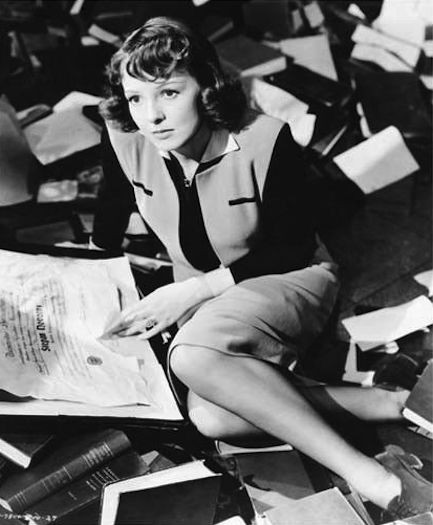 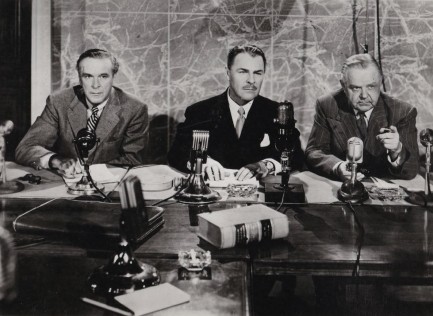 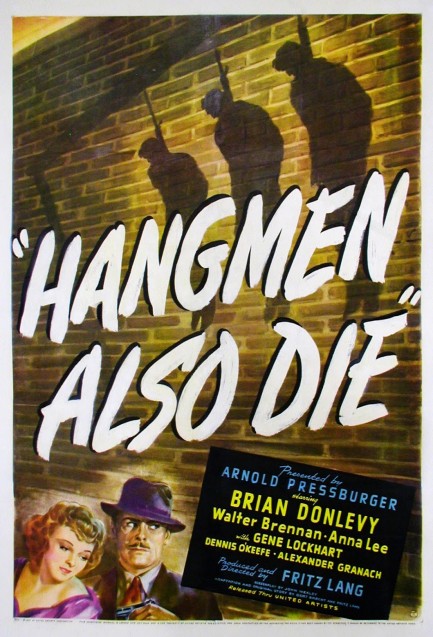
 Who's afraid of him? Nobody anymore. 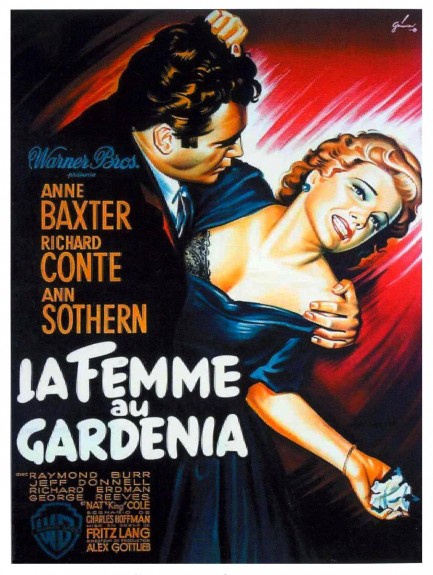
Isn't this a great poster? It was painted for La femme au gardénia, better known as The Blue Gardenia. Every once in a while you come across an old movie that's so ahead of its time you can't believe what you're seeing. This one is about a woman's response to sexual coercion, and law enforcement's reaction to the aftermath. Basically, Anne Baxter, who's five-three and a buck twenty, ends up in the apartment of Raymond Burr, who's six feet and goes at least 230. Burr plies Baxter with booze, and when he later tries to get her horizontal a struggle ensues and he ends up dead. Baxter escapes the apartment, and thanks to the arrival of a very efficient cleaning lady nearly all the evidence of her presence is accidentally erased the next morning before Burr's body is discovered.
So Baxter's scot-free? Well, not quite. There's that whole guilt, edginess, and fear thing, which her roommates notice. And there are a few bits of evidence, which lead to police drawing ever closer. All these are good plot moves. Lacking an identity for the killer, the press begins calling her—the bit of evidence that exists indicates it's a her—the Blue Gardenia, which is a clear Black Dahlia echo. We liked that. And we also liked that, at this point, the film was a thriller built wholly around consent and power. But this was the 1950s. Of course they weren't trying to impart that lesson. What were we thinking? Instead, an ending so pat that it almost ruins the movie comes blundering over the horizon. Is it wrong to suggest watching the first 75 minutes of this and turning it off?
Okay, the movie isn't completely trashed by the ending. It's just that we thought we had something daring on hand, and in reality it's a decent-not-great semi-noir from Fritz Lang that flirts with feminism but decides not to close the deal. However, the story was derived from a novella by author and playwright Vera Caspary, and we can't help wondering if the suits overruled her on a different ending. Probably not, but we'll have to dig that tale up and read it anyway. Regardless, we think the movie is worth watching just for Anne Baxter's bravura performance. And we love the platinum poodle cut she sports too. Plus there's Nat King Cole as, presumably, himself. The Blue Gardenia opened in the U.S. in 1953, and premiered in France today in 1954 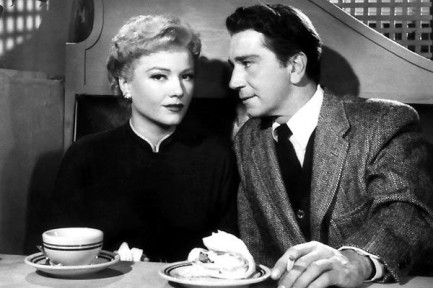 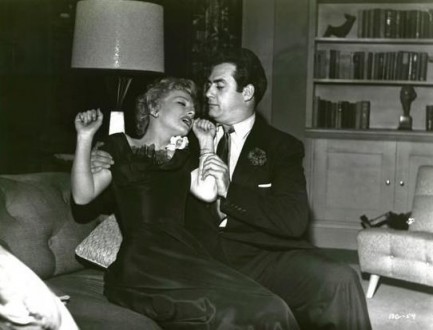 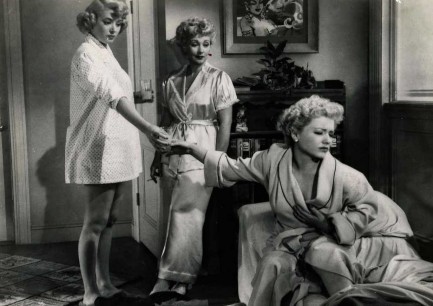 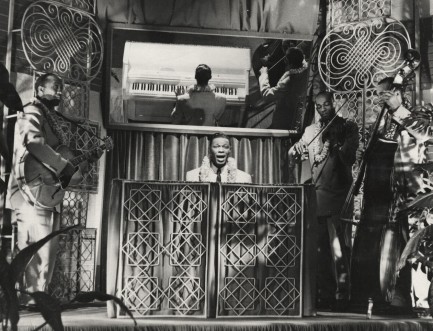 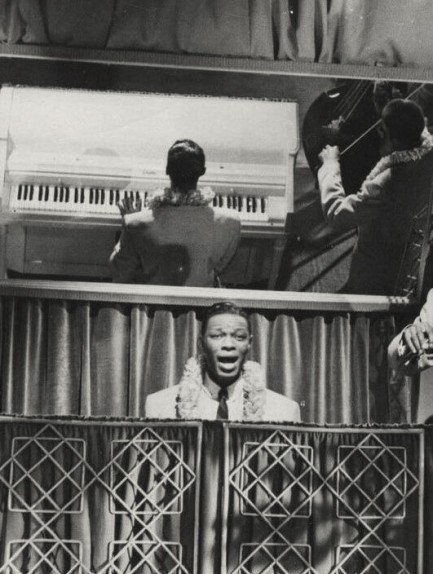 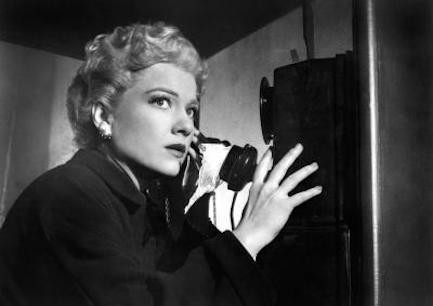 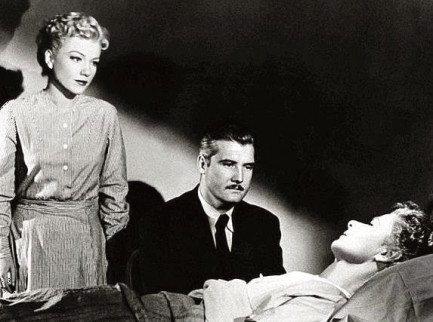 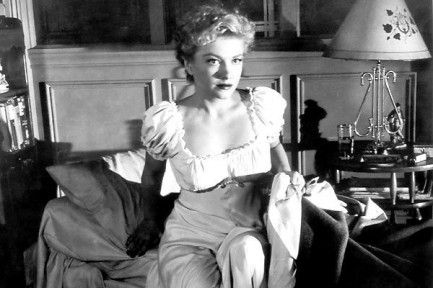
 The temperature rises and the bodies fall in Fritz Lang's tense film noir. 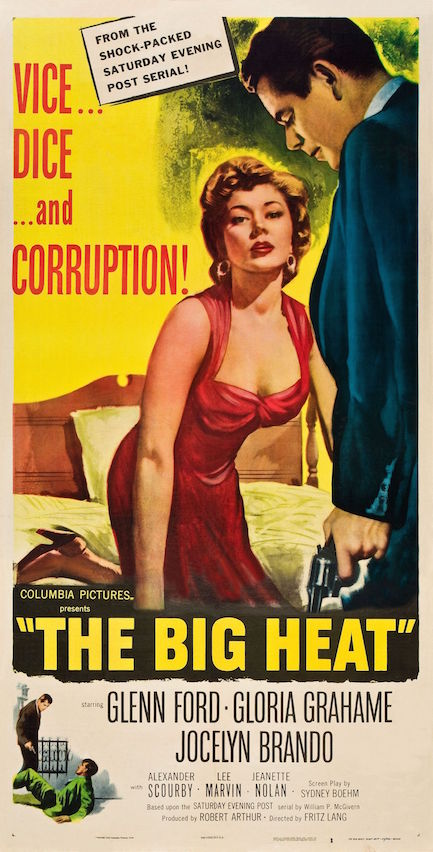
In the thriller The Big Heat, which is based on a novel by William P. McGivern and directed by Fritz Lang, Glenn Ford plays one of the toughest men you'll find in film noir—ass kicking detective Dave Bannon, whose clash with organized crime sends him down a rogue path that leaves people battered, bruised, bloodied, burnt, and blown up. He co-starred with Gloria Grahame, and the way the plot develops, she turns out to be every bit as tough. We can't tell you anything about the movie others already haven't about a thousand times, so we're focusing instead on this top notch promo poster, a framable classic in the panel format we love. You'll see this online only occasionally because it's way too rare for sellers to ever have in stock, but it's a fitting piece for such a great movie. The Big Heat premiered in the U.S. today in 1953. 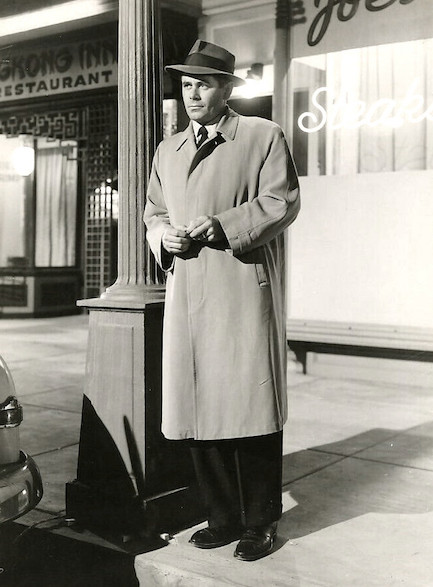 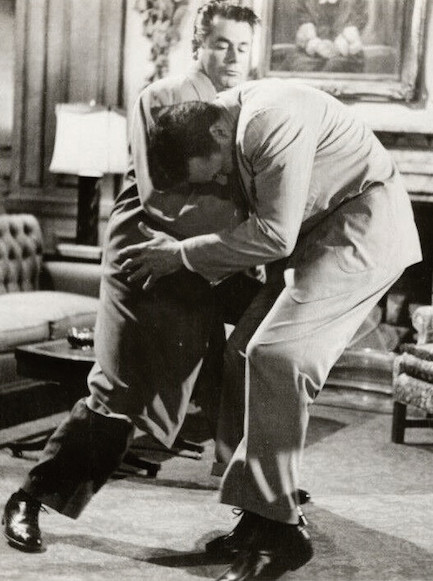 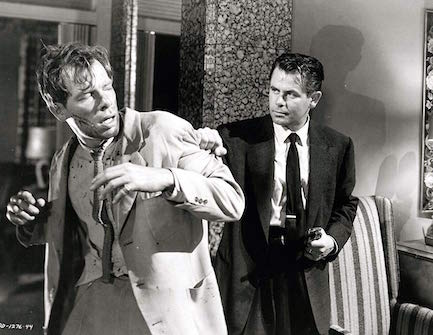 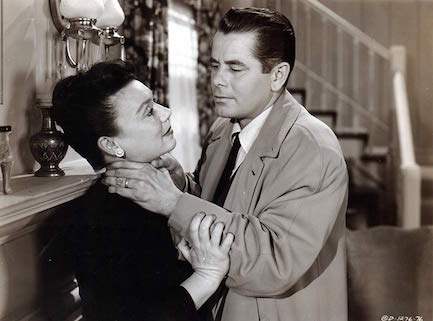 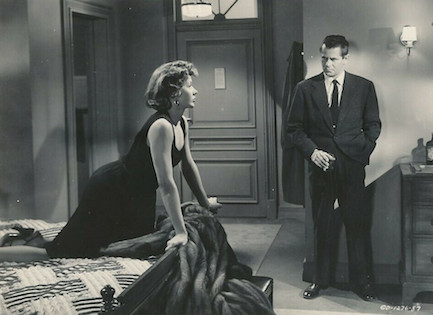 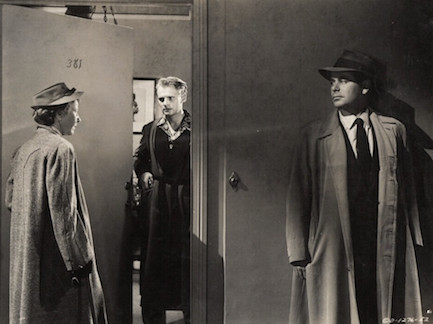 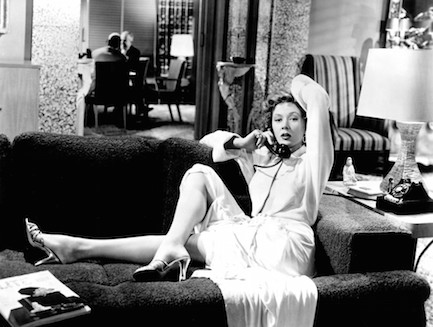 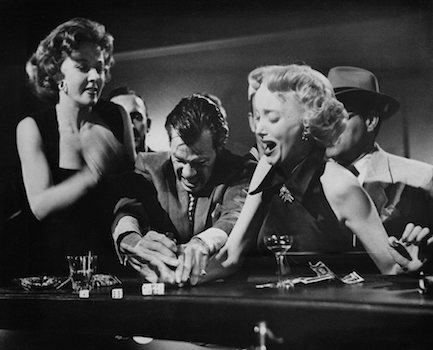 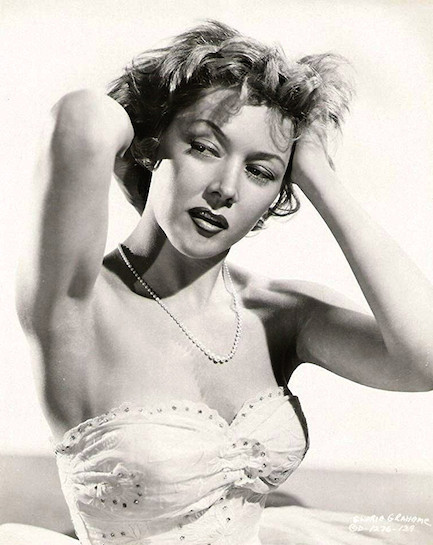 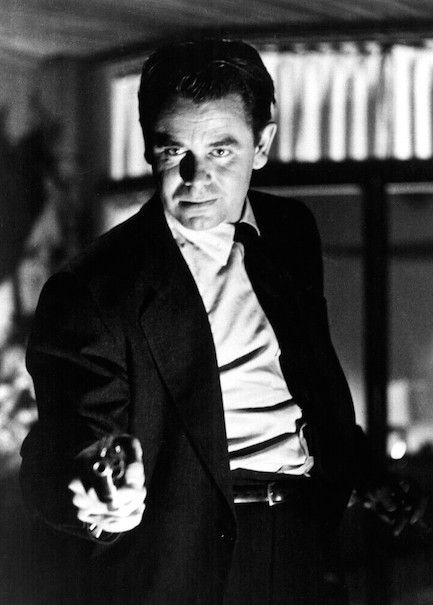
 She's a nightmare on Scarlet Street. 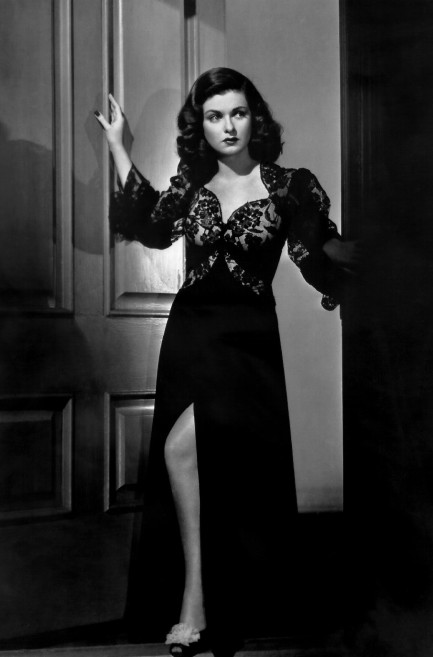
This beautiful photo features U.S. actress Joan Bennett and was made as a promo for her 1945 drama Scarlet Street, in which she plays a con artist who steals credit from a struggling artist for his critically acclaimed paintings. Directed by Fritz Lang and starring Edward G. Robinson and Dan Duryea, it's a solid film noir, well worth seeing. Check out its promo poster at this link.
 Someone in the sleeping compartment isn't going to wake up. 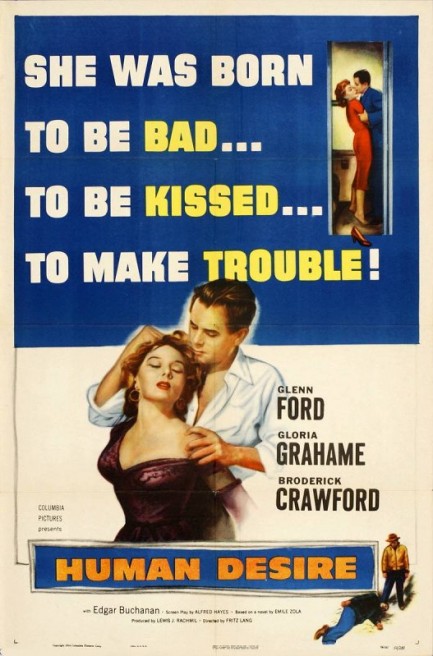
Film noir teaches us that anyone can get in too deep, even a railroad engineer. In Human Desire, Fritz Lang's retelling of Emile Zola's 1890 novel La Bête humaine, Glenn Ford finds himself trapped between lust for Gloria Grahame and reluctance to kill to have her. He's already helped her cover up another killing and gotten in the middle of blackmail plot, but every man has his limits. This is flawed but canonical noir, with a cocky Ford, a quirky Grahame, a brutish Broderick Crawford, and Kathleen Case playing the loyal gal pal, who for our money is much more alluring than Grahame. Ford figures that out too, eventually. Too bad his realization is sandwiched between two murders on his train. Human Desire premiered today in 1954. 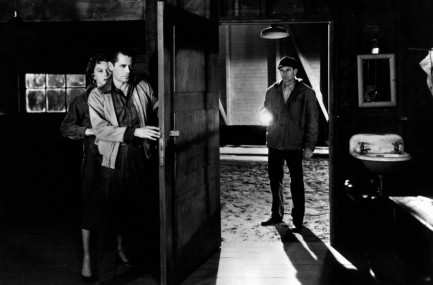 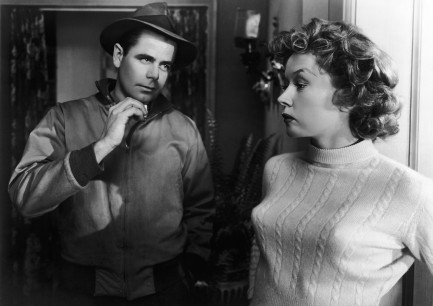 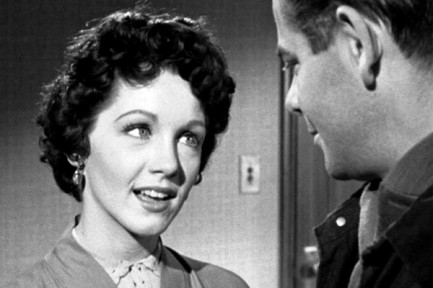 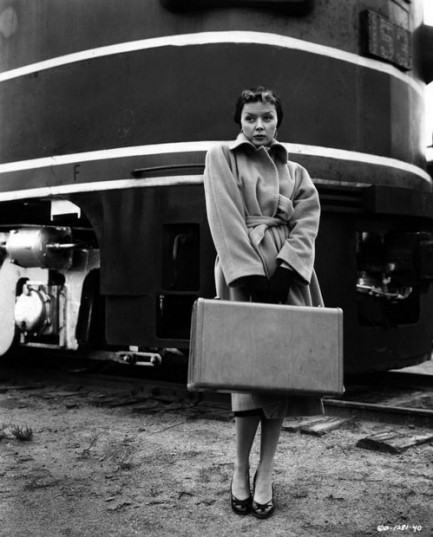

|
 |

The headlines that mattered yesteryear.
2003—Hope Dies
Film legend Bob Hope dies of pneumonia two months after celebrating his 100th birthday. 1945—Churchill Given the Sack
In spite of admiring Winston Churchill as a great wartime leader, Britons elect
Clement Attlee the nation's new prime minister in a sweeping victory for the Labour Party over the Conservatives. 1952—Evita Peron Dies
Eva Duarte de Peron, aka Evita, wife of the president of the Argentine Republic, dies from cancer at age 33. Evita had brought the working classes into a position of political power never witnessed before, but was hated by the nation's powerful military class. She is lain to rest in Milan, Italy in a secret grave under a nun's name, but is eventually returned to Argentina for reburial beside her husband in 1974. 1943—Mussolini Calls It Quits
Italian dictator Benito Mussolini steps down as head of the armed forces and the government. It soon becomes clear that Il Duce did not relinquish power voluntarily, but was forced to resign after former Fascist colleagues turned against him. He is later installed by Germany as leader of the Italian Social Republic in the north of the country, but is killed by partisans in 1945.
|

|
|

It's easy. We have an uploader that makes it a snap. Use it to submit your art, text, header, and subhead. Your post can be funny, serious, or anything in between, as long as it's vintage pulp. You'll get a byline and experience the fleeting pride of free authorship. We'll edit your post for typos, but the rest is up to you. Click here to give us your best shot.

|
|


















 Edit: Vintage movies are excellent windows into bygone customs and practices. There's a great moment in this one. Rhonda Fleming and James Craig are chatting in her apartment late one night when the doorbell unexpectedly buzzes. They look at each other confused for a second, then Fleming says, “It's probably the drugstore. That was the last bottle of Scotch.”
Edit: Vintage movies are excellent windows into bygone customs and practices. There's a great moment in this one. Rhonda Fleming and James Craig are chatting in her apartment late one night when the doorbell unexpectedly buzzes. They look at each other confused for a second, then Fleming says, “It's probably the drugstore. That was the last bottle of Scotch.”







 Here, have your cake. And eat it too. Heh.
Here, have your cake. And eat it too. Heh. I prefer blood sausage for train trips, but I guess it's better for you I'm not shoving one of those in your face, eh?
I prefer blood sausage for train trips, but I guess it's better for you I'm not shoving one of those in your face, eh?
 Wow, you sort of... crush the shit out of your cake before eating it.
Wow, you sort of... crush the shit out of your cake before eating it. Have I been eating cake wrong the whole time I've been in England?
Have I been eating cake wrong the whole time I've been in England?